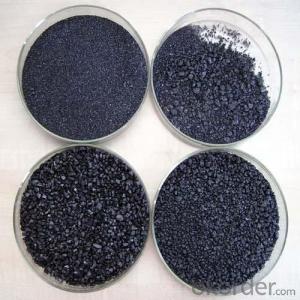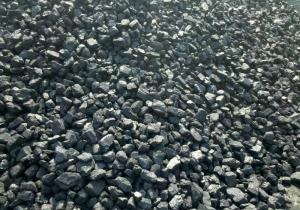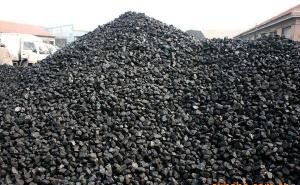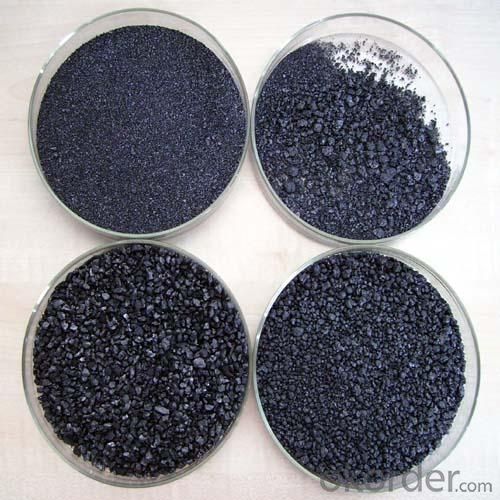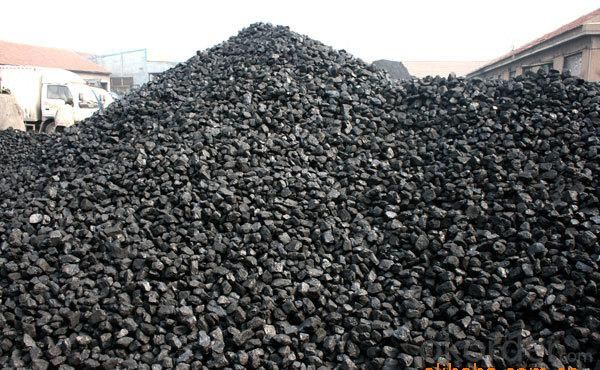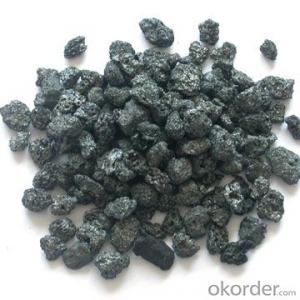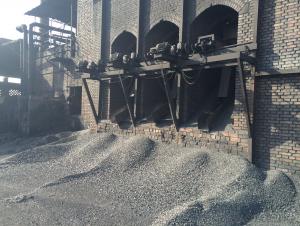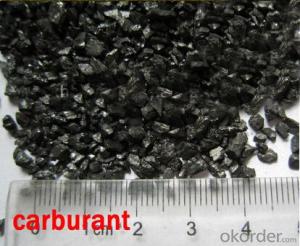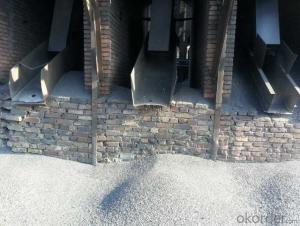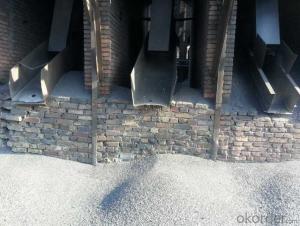Calcined Anthracite High Heat Productivity
- Loading Port:
- Tianjin
- Payment Terms:
- TT or LC
- Min Order Qty:
- 20 m.t.
- Supply Capability:
- 10000 m.t./month
OKorder Service Pledge
OKorder Financial Service
You Might Also Like
Quick Details
Place of Origin: Ningxia, China (Mainland)
Application: steel making
Shape: granule
Dimensions: FC90-95%
Product Type: Carbon Additive
C Content (%): 90-95% MIN
Working Temperature: -
S Content (%): 0.5%MAX
N Content (%): -
H Content (%): 0.6%MAX
Ash Content (%): 8.5%MAX
Volatile: 2%MAX
ADVANTAGE: low ash & sulfur
COLOR: Black
RAW MATERIAL: TaiXi anthracite
Packaging & Delivery
Packaging Details: In 1MT plastic woven bag.
Delivery Detail:30-40 DAYS
Specifications of Calcined Anthracite High Heat Productivity
Carbon Additve low Ash,S,P
FC>95% ASH<4% S<0.3%
It is made from TaiXi anthracite.
instead of pertrol coke reduce the cost
Structure of Calcined Anthracite High Heat Productivity
Shape: granule
Dimensions: FC90-95%
Product Type: Carbon Additive
C Content (%): 90-95% MIN
Working Temperature: -
S Content (%): 0.5%MAX
N Content (%): -
H Content (%): 0.6%MAX
Ash Content (%): 8.5%MAX
Volatile: 2%MAX
ADVANTAGE: low ash & sulfur
COLOR: Black
RAW MATERIAL: TaiXi anthracite
Feature of Calcined Anthracite High Heat Productivity
Specifications (%): | ||||||
Grade | F.C | Ash | V.M | Moisture | S | Size |
CR-95 | ≥95 | <4 | <1 | <1 | <0.3 | 0-30mm |
CR-94 | ≥94 | <4 | <1 | <1 | <0.3 | |
CR-93 | ≥93 | <6 | <1 | <1 | <0.4 | |
CR-92 | ≥92 | <7 | <1 | <1 | <0.4 | |
CR-91 | ≥91 | <8 | <1 | <1 | <0.4 | |
CR-90 | ≥90 | <8.5 | <1.5 | <2 | <0.4 | |
Image of Calcined Anthracite High Heat Productivity
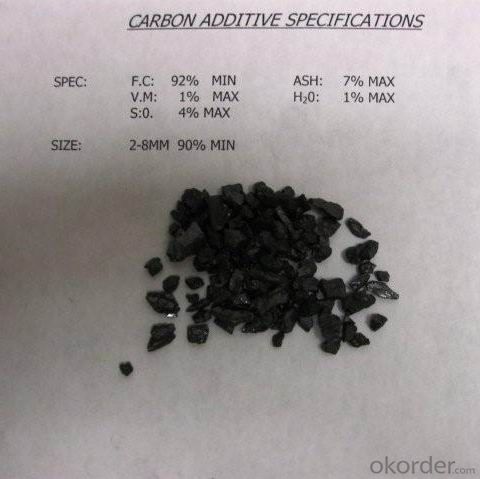


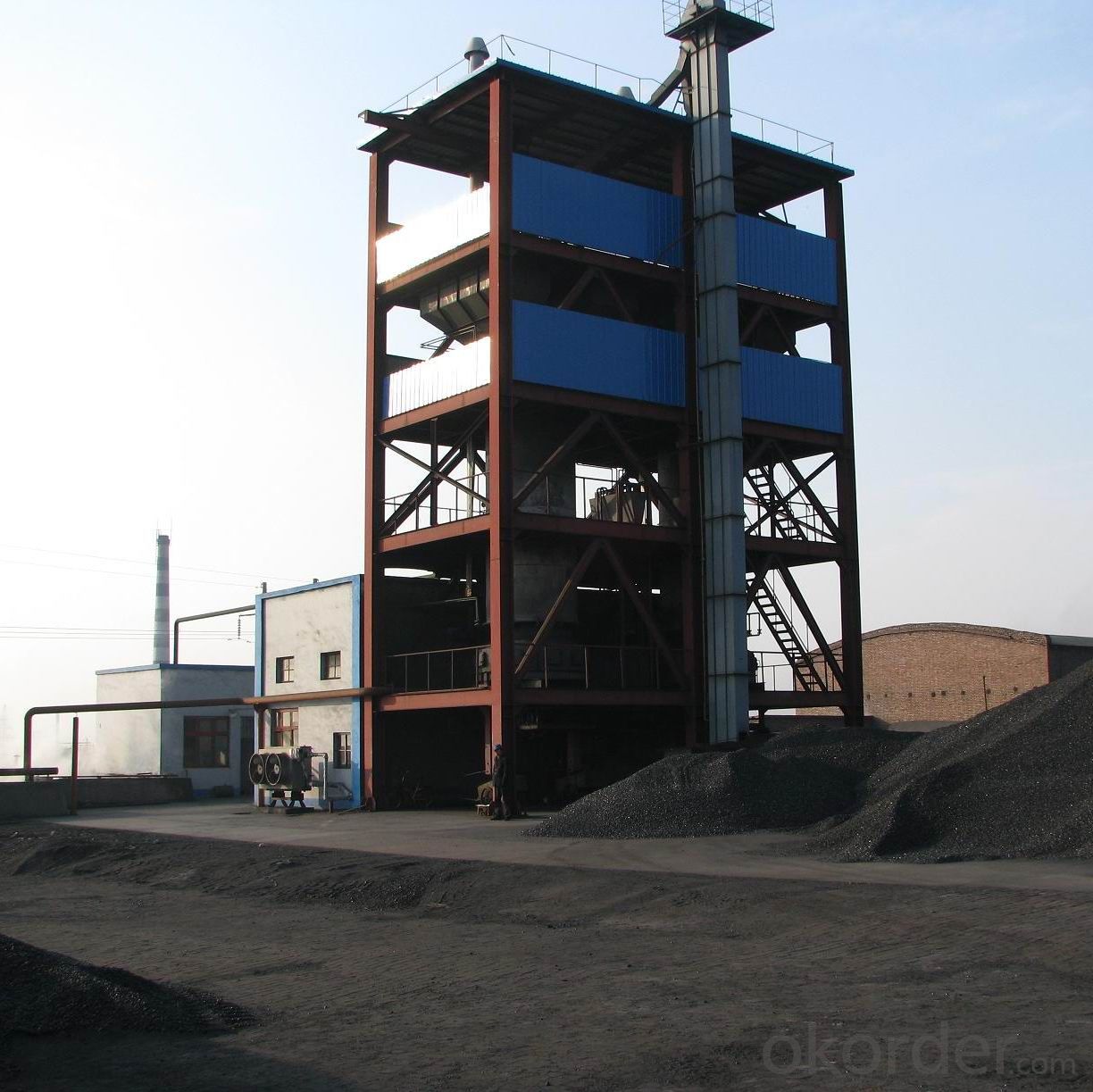


FAQ of Calcined Anthracite High Heat Productivity
Why we adopt carbon additive?
Carbon Additives used as additive in steel making process. It made from well-selected Tai Xi anthracite which is low in content of ash, sulphur, phosphorus, high heat productivity, high chemically activation.
Mainly industry property of it is: instead of traditional pertroleum coal of Carbon Additives, reduce the cost of steelmaking.
Advantage:
Calcined Anthracite High Heat Productivity
1.High quality and competitive price.
2.Timely delivery.
3.If any item you like. Please contact us.
Your sincere inquiries are typically answered within 24 hours.
- Q:How does carbon affect the pH of rainwater?
- Carbon dioxide (CO2) in the atmosphere can dissolve in rainwater to form carbonic acid (H2CO3), which lowers the pH of rainwater, making it more acidic.
- Q:How many electrons does carbon have?
- Carbon has six electrons.
- Q:What are the consequences of increased carbon emissions on coral reefs?
- The consequences of increased carbon emissions on coral reefs are highly detrimental. Elevated carbon dioxide levels in the atmosphere lead to ocean acidification, which negatively impacts the ability of corals to build their calcium carbonate skeletons. This results in weakened and brittle coral structures, making them more susceptible to damage from storms and other environmental stressors. Additionally, higher temperatures caused by carbon emissions contribute to coral bleaching events, where corals expel the symbiotic algae that provide them with essential nutrients and vibrant colors. These combined effects of ocean acidification and warming ultimately lead to significant coral reef degradation, loss of biodiversity, and the decline of ecosystem services provided by these valuable marine habitats.
- Q:What are the effects of carbon emissions on freshwater systems?
- Freshwater systems are significantly affected by carbon emissions, with one major consequence being the acidification of water bodies. When carbon dioxide dissolves in water, it creates carbonic acid, resulting in a decrease in pH levels. This acidification negatively impacts freshwater organisms like fish, amphibians, and invertebrates, as it disrupts their physiological processes and can even lead to their death. Furthermore, carbon emissions contribute to global warming, which in turn has an impact on freshwater systems. Rising temperatures can lead to increased evaporation, causing water scarcity in specific regions. This scarcity has severe implications for both human populations and ecosystems that rely on freshwater resources. Additionally, the warming of freshwater systems can disturb the balance of the ecosystem by promoting the growth of harmful algae blooms. These blooms thrive on excess nutrients, such as nitrogen and phosphorus, which are often present in runoff from agricultural and urban areas. The combination of higher temperatures and nutrient enrichment can result in the proliferation of harmful algae, which produce toxins that are harmful to aquatic life and human health. Moreover, carbon emissions indirectly affect freshwater systems through their contribution to climate change. As global temperatures rise, glaciers and polar ice caps melt, leading to an influx of freshwater into the system. This sudden increase in freshwater disrupts the delicate balance between saltwater and freshwater ecosystems, affecting the distribution and migration patterns of various species. It also alters salinity levels, impacting the survival and reproduction of marine organisms. In conclusion, carbon emissions have various negative effects on freshwater systems, including acidification, water scarcity, the proliferation of harmful algae blooms, and disruptions to the delicate balance between saltwater and freshwater ecosystems. It is crucial to reduce carbon emissions and mitigate the impacts of climate change to protect the health and sustainability of freshwater systems.
- Q:How does carbon affect the quality of soil?
- Carbon plays a crucial role in improving the quality of soil. It enhances soil fertility by serving as a food source for beneficial microbes and earthworms, which aid in breaking down organic matter and releasing essential nutrients. Additionally, carbon improves soil structure and water-holding capacity, promoting better root growth and reducing erosion. Overall, the presence of carbon in soil is vital for its health and productivity.
- Q:How does carbon contribute to the strength of alloys?
- Carbon contributes to the strength of alloys by forming interstitial solid solutions with metals, which increases the hardness and strength of the material. The carbon atoms occupy the spaces between the metal atoms, creating lattice distortions and enhancing the overall strength of the alloy. Additionally, carbon can also form compounds with metals, such as carbides, which further improve the hardness and wear resistance of alloys.
- Q:other parameters are figured out, the difference is only in the carbon and carbon is not very clear, just know that they are winding mode is the opposite, there are two kinds of most printers can be used, what is the difference between the performance of them? Two can use the printer in the selection of the best carbon or carbon? Why? Please cite several models as an example.Please answer in your own words. Don't factor,
- SATO machine with carbon is better, and the CITIZEN printer inside and outside carbon can be used, in addition to machine limitations, not what the difference is too big, the quality of internal and external carbon ribbon is the same.
- Q:How are carbon nanotubes produced?
- Carbon nanotubes are produced through a process called chemical vapor deposition (CVD), which involves the use of a carbon-containing gas and a catalyst. In this process, a substrate is coated with a catalyst material, usually iron, nickel, or cobalt. The substrate is then placed in a high-temperature furnace, typically around 800-1000 degrees Celsius, and exposed to a carbon-containing gas, such as methane or ethylene. As the gas decomposes at high temperatures, carbon atoms are released and deposited onto the catalyst nanoparticles on the substrate. These carbon atoms then arrange themselves in a hexagonal pattern, forming a tube-like structure, which grows vertically from the catalyst particles. The growth of the nanotubes is driven by the difference in carbon solubility between the catalyst and the growing tube. The diameter, length, and alignment of the carbon nanotubes can be controlled by adjusting various parameters such as the temperature, gas flow rate, and catalyst material. By manipulating these parameters, researchers can produce carbon nanotubes with specific characteristics suitable for various applications. It's worth noting that there are other methods to produce carbon nanotubes, such as arc discharge and laser ablation, but CVD is the most commonly used method due to its scalability and ability to produce large quantities of nanotubes. Additionally, CVD allows for the growth of vertically aligned nanotube arrays, which are highly desirable for many applications.
- Q:How does carbon dioxide affect the Earth's atmosphere?
- Carbon dioxide affects the Earth's atmosphere by trapping heat from the sun, leading to the greenhouse effect and causing global warming and climate change.
- Q:What is the role of carbon in organic chemistry?
- Organic chemistry heavily relies on carbon, a fundamental element that plays a crucial role in the structure and function of organic compounds. Its exceptional ability to form stable covalent bonds with both carbon and a wide range of other elements leads to the immense diversity of organic molecules found in nature. Carbon's capacity to bond with itself and other elements allows for the creation of long chains, branched structures, and ring systems, resulting in the complex and distinctive shapes characteristic of organic compounds. In the realm of organic chemistry, carbon acts as the foundation for many vital biomolecules essential for life, such as carbohydrates, lipids, proteins, and nucleic acids. It serves as the basis for the structural variety and intricacy observed in living organisms. Additionally, carbon's ability to form multiple bonds and its tetrahedral geometry contribute to the versatility of organic compounds, enabling the presence of various functional groups like hydroxyl, carbonyl, amino, and carboxyl groups. Moreover, carbon's aptitude for undergoing chemical reactions, including oxidation, reduction, addition, substitution, and elimination reactions, holds significant importance in organic chemistry. These reactions are fundamental for synthesizing and modifying organic compounds, facilitating the creation of new molecules with specific properties and functions. Carbon's central role in organic chemistry extends further to the study of reaction mechanisms, stereochemistry, and comprehending the behavior and reactivity of organic compounds. In summary, carbon's exceptional properties and its capacity to form stable covalent bonds with other elements serve as the cornerstone of organic chemistry. Its presence allows for the vast array of organic compounds that exist, while its participation in chemical reactions enables the synthesis and manipulation of these compounds. Without carbon, the field of organic chemistry and the study of life's fundamental building blocks would be impossible.
1. Manufacturer Overview |
|
|---|---|
| Location | |
| Year Established | |
| Annual Output Value | |
| Main Markets | |
| Company Certifications | |
2. Manufacturer Certificates |
|
|---|---|
| a) Certification Name | |
| Range | |
| Reference | |
| Validity Period | |
3. Manufacturer Capability |
|
|---|---|
| a)Trade Capacity | |
| Nearest Port | |
| Export Percentage | |
| No.of Employees in Trade Department | |
| Language Spoken: | |
| b)Factory Information | |
| Factory Size: | |
| No. of Production Lines | |
| Contract Manufacturing | |
| Product Price Range | |
Send your message to us
Calcined Anthracite High Heat Productivity
- Loading Port:
- Tianjin
- Payment Terms:
- TT or LC
- Min Order Qty:
- 20 m.t.
- Supply Capability:
- 10000 m.t./month
OKorder Service Pledge
OKorder Financial Service
Similar products
New products
Hot products
Hot Searches
Related keywords
